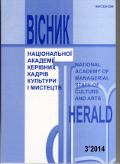ETHNIC FONTS IN THE PACKAGING DESIGN
DOI:
https://doi.org/10.32461/2226-3209.3.2014.138133Keywords:
typography, lettering, ethnic fonts, packaging designAbstract
Globalization processes take currently place in the world. They promote active development of graphic design
as a communicative component of modern society and in particular packaging design. One of the cultural area objectives can be formation national consciousness, a sense of ethnicity based on great cultural traditions among the Ukrainian people. The issue of national identity quest one should find in all areas of graphic design and especially in the design of packaging. Packaging has the greatest impact and the possibility of regular reminder to our contemporaries of the ancient roots of the indicated cultures. That could be possible because o its proximity to a particular consumer.
In today’s society the leading position among the artistic imaginative graphics belong to such important form as font. Font exists and develops along with the art of its time. Overall, a well-ordered approach to the isolation of fonts (font graphics) in a separate artistic practice has almost centenary history. Analysis of the masters activity in the area of font graphics determines a pattern: every day artists inspired by the idea to express the mentality of its people, turned to ancient folk heritage. This heritage created the universal codes of ethnic attitude. The artists transformed them according to their current art world trends. The font contains traditional symbols for every written culture. It helps to identify visually the features of the proposed national artistic and graphic solutions and to construct a visual identity system of graphic design in packaging. The article outlines the feature use of ethnic fonts in the process of creating packaging design and features perception by consumers. The article shows the stage of typography study in the context of using font ethnic forms in the practical packaging design. Since the potential consumers of goods and products are people of different nationalities with a rich tradition and history around the world, the issue of searching the national identity is activated. Because of using the fonts with national colors, designers can create a design that will seperate the product in a particular commodity segment. One can easily determine which national or even geographical region the inscription belongs to according to its graphics drawing fonts. The so-called national fonts have unique image that reflect national character the best way. At the first glance at the packaging, which is made in national traditions, we can almost accurately assign it to a particular geographic region or ethnic. Based on the analysis of the collected material the article determines that the process of combination of the old standard fonts, mixing them with updated and new fonts and graphic elements of the national is one of the current trends in the design of modern packaging. Fonts with distinctive national features may be composite and meaningful solution by themselves if such a solution is the general concept of promotion and positioning of certain goods. The designers in the process of making a new packaging should inextricably bind the symbolic font forms with graphic object. They have to have rich combination of stock options in their store – from
classic, well-established and proven ones to innovative, yet proven suggestions. The author of the article proposes to
include the discipline of design packages using the basics Ukrainian typography in the syllabus.
Downloads
Published
Issue
Section
License
Authors who publish with this journal agree to the following terms:
1. Authors retain copyright and grant the journal right of first publication with the work simultaneously licensed under a Creative Commons Attribution License that allows others to share the work with an acknowledgement of the work's authorship and initial publication in this journal.
2. Authors are able to enter into separate, additional contractual arrangements for the non-exclusive distribution of the journal's published version of the work (e.g., post it to an institutional repository or publish it in a book), with an acknowledgement of its initial publication in this journal.
3. Authors are permitted and encouraged to post their work online (e.g., in institutional repositories or on their website) prior to and during the submission process, as it can lead to productive exchanges, as well as earlier and greater citation of published work (See The Effect of Open Access).


